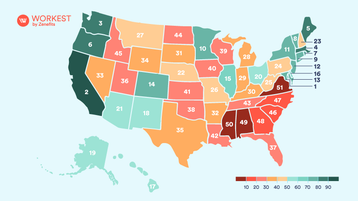
From attracting and keeping talent to staying compliant with local, state, and federal regulations, workplace benefits are a big deal. It’s no surprise that 44% of the companies that made Fortune’s 100 Best Companies to Work For in 2020 offer not just healthcare benefits, but on-site medical care while 12 of the 100 companies pay for 100% of their full-time employees’ healthcare benefits. While that’s almost certainly not possible for the majority of small businesses around the United States, there are plenty of other factors to consider when determining where the U.S. ranks in comparison to other countries when it comes to work benefits. TriNet has uncovered how the U.S. compares to other countries when it comes to workplace benefits. Unfortunately, it’s dead last (among developed countries like the U.S., at least). Want to know how your business compares to the country as a whole? Curious about what went into the ranking? Read on to find out how America has fared in the battle for the best work benefits, broken down by component, and the data we used to arrive there.
Healthcare
Despite the myriad of benefits that have become customary in some American employment circles (on-site daycare at giant tech companies), the first central element of work benefits in the U.S. is bound to be healthcare. The U.S. is the only industrialized country that doesn’t have universal healthcare for its citizens, which means it’s behind many, many other countries right off the bat by relegating it to employer benefits rather than human rights in the first place. When it comes to the public healthcare systems that workers have access to, the U.S. is 15th in the world according to U.S. News and World Report which gives Canada, Denmark, Sweden, and Norway the top places.
List of best healthcare benefits by country
- Canada
- Denmark
- Sweden
- Norway
- Germany
- United Kingdom
- Japan
- Australia
- The Netherlands
- Switzerland
What really brings the U.S. down is the fact that hospitals are private, save for those under the Veterans Health Administration. Overall, the U.S.’s approach to healthcare chiefly entails offering private insurance through employment or exchanges established by the Affordable Care Act, a single-payer system for those 65 and older only (Medicare), and a state-managed system for low income people (Medicaid). Add the 27.5 million people who have no insurance at all to the mix, and that’s the grim situation that U.S. workers have to navigate for healthcare. Plus, especially when it comes to employers spending on their employees’ healthcare, there’s another harrowing statistic to note: As a share of its economy, the United States spends more on healthcare than other high-income countries. If you’d expect that investment to get us somewhere when it comes to health outcomes, guess again. While the U.S. fares well when it comes to some preventative measures, the country still has the highest number of hospitalizations from preventable causes and the highest rate of avoidable deaths compared to peer nations.
Retirement
Well, there’s a reason so many Americans become expats when they retire — life overseas can be much better for retirees, especially when they have dwindling employer benefits to help them retire comfortably. Out of 44 countries analyzed in the annual Global Retirement Index put together by Parisian investment bank Natixis Investment Managers, the U.S. ranks 16th, up from 17th in 2018 and 18th last year. For workers of color, the situation is even more grim. People of color are significantly less likely to be covered by an employer-sponsored retirement plan. While 24% of white households are covered, just 16% of households of color are. As a result, 3 out of 4 Black households and 4 out of 5 Latinx households have less than $10,000 in retirement savings. Add to that the fact that 69% of Latinx households and 62% of Black households have no retirement savings at all while the same is true for just 37% of white households (still a large number).
Paid time off
Paid time off is a central benefit that employees across the world look for. This is also where the U.S. struggles to keep up — it’s the only advanced economy that does not guarantee workers any paid vacation time. Further, the United States falls even farther behind when paid holidays are included. Because the U.S. doesn’t guarantee any paid holidays while other wealthy countries typically offer between 5 and 13 each year. By contrast, European workers get at least 20 paid vacation days each year with 30 days becoming the common expectation. As most people know, there’s a reason most of Europe is a dead zone in August — tons of people opt to take the entire sweltering month off and opt for vacations instead, because they can.
Paid sick days
Of the 22 countries that the Center for Economic Policy and Research looked at, the United States is the only one that doesn’t guarantee workers any form of paid sick leave. Further, it’s the only country of the 22 — ranging from Luxembourg (the best) to Germany, Italy, and Canada — that doesn’t offer paid sick leave for workers undergoing cancer treatments and is 1 of just 3 countries that doesn’t provide 5 paid days off of work for workers with the flu.
Parental leave
Along with countries like Lesotho, Liberia, Papua New Guinea, and Swaziland, the U.S. is one of just a handful of countries (that’s countries in general, not just developed countries) that doesn’t require paid maternity leave (outside of certain federal employees, that is). While the United States does require 12 weeks of unpaid protected leave for certain workers, many can’t afford the loss of income and forgo it. By contrast, in Finland new mothers get 161 weeks off, Germany and Japan offer 58 weeks, Canada offers 52, and Ireland offers 26.
Work-life balance
The truth is that benefits aren’t as clear cut as they were before when it was all about 401(k)s and pensions. Today, especially in places where paid time off is scarce, employees are increasingly looking to find a balance between the work they can’t afford to take time off of and the demands of their daily lives. Thus, work-life balance has become a valued benefit around the world. This is one area where the U.S. enjoys a placement that is nearer to the middle of the 35 countries surveyed by the Organization for Economic Cooperation and Development. While the Dutch enjoy the most balanced approach to employment, countries like Colombia, Mexico, Turkey, Korea, and 7 others are worse off than the U.S. which comes in at the 11th worst.
Unemployment
According to a 2016 Glassdoor report compiled in conjunction with Llewellyn Consulting, the U.S. lands somewhere near the middle of a pack of 15 developed countries examined when it comes to unemployment benefits —both the benefits themselves and eligibility. Unemployment benefits are best in countries like Belgium, Denmark, and the Netherlands and are the least generous in places like the United Kingdom, Austria, and Ireland. The United States was the 3rd “least generous” with unemployment pay and the 2nd least generous with the period of time that unemployment covers. To put it into context, whereas Denmark offers 90% of an employee’s previous earnings for up to 104 weeks, the United States offers between 40% and 50% of previous earnings for up to 26 weeks depending on individual states — some states are more generous while others are stricter.
Top 10 countries in worker benefits
After sorting through the central benefits variables, here is our definitive list of the best countries for workplace benefits:
- Denmark
- The Netherlands
- Finland
- Sweden
- Switzerland
- Norway
- Germany
- The United Kingdom
- Canada
- Japan
The U.S. did not make the top 10 list*. Often, the U.S. ranks alongside other developing countries when it comes to the factors that contribute to its rating, so the United States is easily outranked by pretty much all other developing countries. To see where the U.S. lies, you’ll have to get all the way down to number 30 on the list: 11. Lithuania 12. Ireland 13. Luxembourg 14. Portugal 15. Spain 16. France 17. Italy 18. Austria 19. Australia 20. New Zealand 21. Bulgaria 22. Israel 23. Turkey 24. Estonia 25. Hungary 26. Czech Republic 27. Latvia 28. South Korea 29. Mexico 30. United States *Compiled from 16 sources on global employee benefits ranging from maternity and paternity leave to the number of paid vacation days and amount of paid leave, the countries were ranked by scoring three points each time they ranked in the top third of a given report or list, two points for ranking in the middle third, one for ranking in the last third, and zero for appearing on a report or list at all. The countries are ranked from those with the most points to those with the least.
So, where does each U.S. state stand in the Benefits Rankings?
Of course, things can look a little different on the ground in the United States. An important thing to note is that the United States is exactly that, a union of states. Federal employment policies are often more like minimum standards that states are free to expand upon and further determine. This means that the situation in one state can be better or worse than a situation in another, and that is certainly the case. By and large, red states in the Midwest and the South are worse states for workers than blue states along the coasts.
Looking ahead to 2021
Despite the differing situations from state to state, there’s little question that, as a country, the U.S. has a long way to go to catch up to the workplace benefits that other developed countries offer. New 2021 policy could help move the United States in the right direction. Here are some potential impacts to American worker's benefits that could come from the new administration:
- PAID LEAVE. Family and Medical Leave Act (FMLA) allows for 12 weeks of paid family and medical leave. Progressives want to expand that effort, in the form of the Family and Medical Insurance Leave (FAMILY) Act. The act would expand the qualified reasons for taking paid leave and opens eligibility to more workers.
- MINIMUM WAGE. Many states have started gradually increasing their minimum wages at the end of 2020, but not all of them. Biden has stated his desire to increase the federal minimum wage to $15 per hour by 2026 and eliminate the tipped wage. The federal minimum wage is currently $7.25 and has historically only increased by a couple of dollars every 2 decades. This would be one of the most significant increases to the federal minimum wage in history.
- EMPLOYEE DATA SECURITY. At its core, Employee Data Security legislation, such as the CCPA enacted in California, is the right to know what data businesses collect about them, delete some of that information, opt out of the sale of personal data and avoid discrimination as a result of exercising their CCPA rights. If enacted, expanded consumer privacy legislation on a federal level may resemble something akin to the General Data Protection Regulation (GDPR) of Europe. This would mean a greater burden on employers to protect worker's privacy. Related, 2021 Legislation has already been passed to assist with worker safety.
Sources:
- https://www.glassdoor.com/
- https://www.oecd.org/
- http://www.frac.tl/
- https://www.statista.com/
- https://www.oecd-ilibrary.org/
- https://theconversation.com/
- https://cepr.net/documents/
- http://www.oecdbetterlifeindex.org/
- https://theonebrief.com/
- https://policy-practice.oxfamamerica.org/
- https://www.im.natixis.com/us/
- https://axenehp.com/
- https://www.usnews.com/
- https://www.census.gov/
- https://www.commonwealthfund.org/
This communication is for informational purposes only; it is not legal, tax or accounting advice; and is not an offer to sell, buy or procure insurance.
This post may contain hyperlinks to websites operated by parties other than TriNet. Such hyperlinks are provided for reference only. TriNet does not control such web sites and is not responsible for their content. Inclusion of such hyperlinks on TriNet.com does not necessarily imply any endorsement of the material on such websites or association with their operators.






